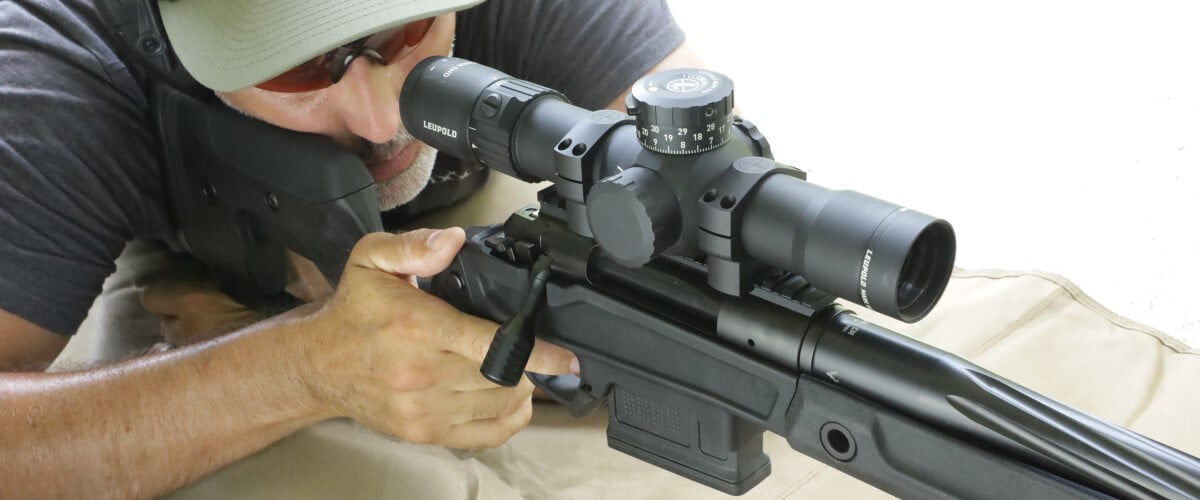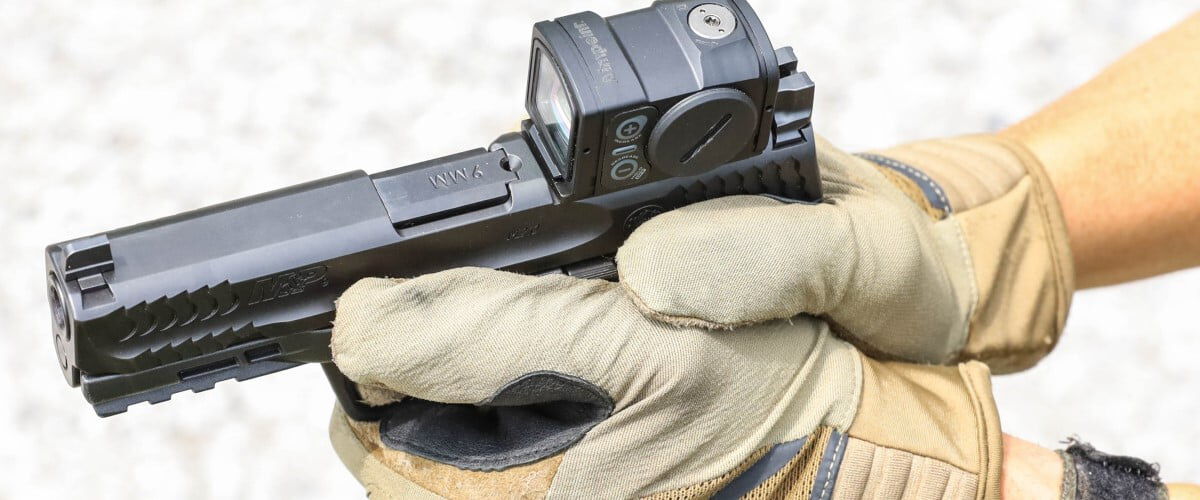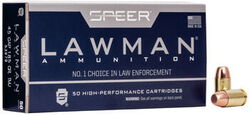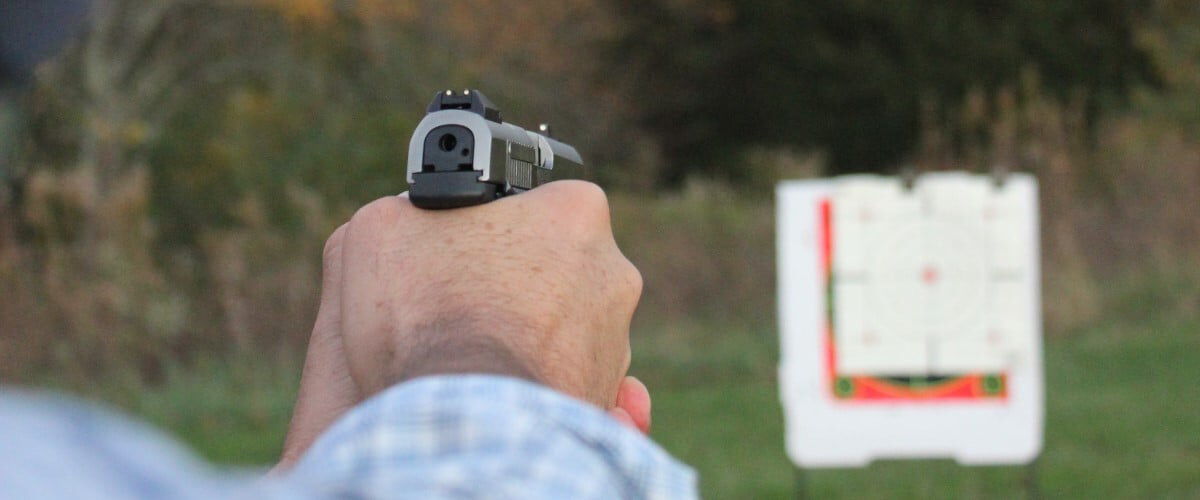
Whether you’re a USPSA Grandmaster, shoot PRS matches, or are new to shooting, you’re probably trying to improve your speed and accuracy with a firearm. One of the most exciting elements of shooting is seeing yourself get better. Conversely, one of the most frustrating elements is when you don’t shoot well and don’t know why.
Here is a list of the most common errors for both handguns and rifles. If you’re seeing your performance deteriorate consistently or you are simply having a bad day at the range, one or more of these issues is probably to blame. Being able to diagnose problems and fix them is a critical first step toward improving your overall performance.
Eye Dominance
Most experienced shooters understand eye dominance, but it’s an important concept for new shooters to comprehend. Most people have a dominant eye, and identifying which of your eyes is dominant is a critical first step toward improving your shooting—especially if you are one of the millions of Americans who are cross-dominant. Cross dominance occurs when your strong hand and strong eye are on different sides of the body.
The simplest test for eye dominance is to choose an object across the room (faces in pictures or a specific number on an analog clock work well) and point at it. Holding your finger in that position, close one eye and then the other. Odds are that the relative position of your finger will move dramatically when one of your eyes is open. That’s your weak eye. When the other eye is open your finger will probably stay very close to where you pointed, and that’s your dominant eye.
If the dominant eye and dominant hand are on the same side of your body, that’s great news—you shouldn’t have issues with eye dominance while shooting. If you’re cross-dominant, you’ll need to make some type of adjustment. My wife was a very good college basketball player who once held the record for three-point shots in a season, but she absolutely could not hit trap targets. Not surprisingly, she is cross-dominant, and once we remedied the problem she became a deadly shot with a shotgun.
So how do you remedy cross-dominance? There are multiple methods. One is to learn to shoot with the other hand, but if that’s simply not possible, you can close your eye or add tape to cover the strong-side lens of your shooting glasses. Red dot optics are great for cross-dominant shooters, or you can employ the Chapman Shooting Stance where you place your chin against the bicep of your shooting arm, effectively aligning your dominant eye with the iron sights.
Body & Hand Position
Proper hand position is critically important when shooting a handgun. A low grip can induce muzzle flip and make fast follow-ups all but impossible. The most common grip for pistols is the two thumbs-forward hold, which requires the shooter to hold the gun high on the pistol grip, wrap the fingers around the grip, and then wrap the fingers of the weak hand around those of the strong hand. The weak-side and strong-side thumbs both point toward the target along the frame of the pistol, providing a secure hold on the firearm. The weak-hand grip should be firm to stabilize the gun and help keep that muzzle down for fast follow-ups.

Hand position is also important when rifle shooting. When I attended a long-range rifle course instructed by Navy SEAL Jay Manty, he spent a great deal of time requiring shooters on the line to lift their fingers off the pistol grip of the rifle to ensure a light hold. In target rifle shooting, the rear hand’s primary role is to press the trigger. A tight hold on the pistol grip makes a smooth trigger pull more difficult. If you need further proof of this concept, simply look at the grip of today’s top rifle match shooters. In most cases, their thumb rides on the top or strong-hand side of the pistol grip, eliminating the risk of developing too tight a handhold. Modern long-range rifles are even built with specialized thumb rests for shooters who maintain this hand position.
Sight Picture & Optics
Sight picture is critically important when shooting, but developing a clear sight picture can be difficult. In pistol shooting, focus should be on the front sight when using irons, and some people have trouble concentrating on this objective. Others simply can’t see well enough to make out iron sights because of their limited vision.
This is part of the reason why red dot sights are so popular. Red dots have been used on carbines for years, but they have now made their way onto pistols and most new carry guns are cut for optics. Because shooters stay target-focused when using a red dot, they tend to shoot accurately more quickly, and the concept of “putting the dot where you want to hit” is simpler than aligning iron sights. I’ve seen rapid and dramatic increases with accuracy when new shooters switch to a red dot.

Lawman
Build good shooting habits with training ammunition that performs like self-defense loads. Lawman uses a TMJ bullet with a plated jacket that encapsulates the entire lead core.
Buy NowMagnified optics are also a great choice and are standard fare on rifles, but are you getting the most from your scope? Making sure the parallax and eyepiece are adjusted correctly is the first step. Also, most shooters use a higher magnification range than is required. One of the most valuable exercises I ever conducted was at a long-range shooting event where the instructor required everyone to hit targets at 1,000 yards on 10x magnification, which was not only possible, but the number of on-target hits remained relatively consistent.
Fatigue & Flinching
Flinching is a natural reaction to the impact and muzzle blast of firing a gun. It’s a common problem among shooters, both new and experienced. To remedy this, don’t shoot hard-recoiling rifles and handguns excessively, and practice safely dry firing an unloaded firearm. Muzzle brakes help reduce recoil impact, but they also increase muzzle blast, which can actually make a flinch worse. I much prefer a suppressor and recommend everyone own them for their firearms. In addition to reducing muzzle blast, they also reduce recoil because of added weight.
At some point, even with a suppressor, we all reach the point of diminishing returns. Just like a runner who might benefit from a 3-mile run is only opening themselves to injury with a 10-miler, shooters need to know when they have reached their limit. Groups that suddenly open up prompts many shooters to continue putting shots downrange, and this only adds to fatigue. At some point you’ll need to back off, so learn to recognize the symptoms of fatigue like diminishing accuracy.
Trigger Control
Proper trigger control is critical, and it starts with a good trigger. Today’s handguns and rifles have far better triggers than many models from just a few years ago, but you might want to adjust trigger pull weight or have a gunsmith do it. Triggers should be pulled straight rearward with steady, even pressure. Shooters who “pull” the trigger by applying uneven angular pressure also rotate the firearm. Even minor movements can make a major change in accuracy. This is less of a problem when shooting rifles on fixed rests but is a major issue with handguns. Typically the shooting finger pulls the muzzle down and to the weak-handed side of the target (low left for right-handed shooters, low right for lefties). If you’re seeing some or all your shots hitting low left it may be a loose or poorly adjusted sight, but it might also be bad trigger pull.

Some guns (particularly top-end centerfire rifles) offer trigger pull length adjustments or at least stock spacers that allow you to adjust overall length of pull. If your finger naturally aligns with the face of the trigger you’re less apt to pull the trigger to the side as it breaks.
Ammunition Selection
This is critical. Oftentimes simply switching ammunition will solve accuracy problems, and I saw a very clear example of this last year when a friend was planning an elk hunt but was having trouble getting his rifle to group with his chosen ammunition. I suggested he shop around for premium hunting ammunition and he found that the same rifle that was grouping 2 inches at 100 yards was suddenly producing sub-MOA groups with better ammo. Both centerfire and rimfire handguns and rifles benefit from better ammunition, and some cheap imported ammo has a poor reputation for quality control and produces widely varying velocities. To-shelf ammunition costs a bit more than cheap imported stuff, but I’ve found the benefits outweigh the costs.